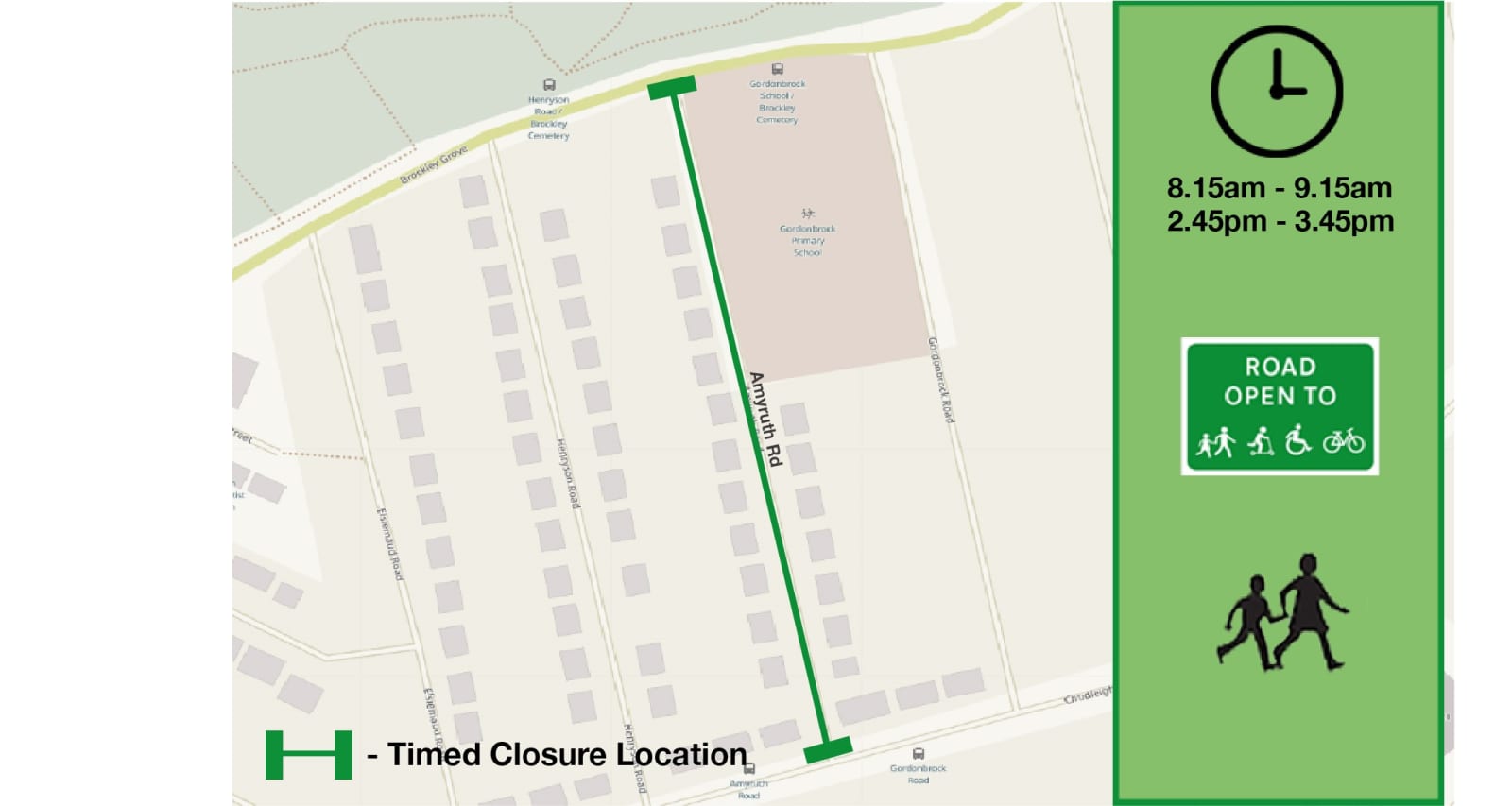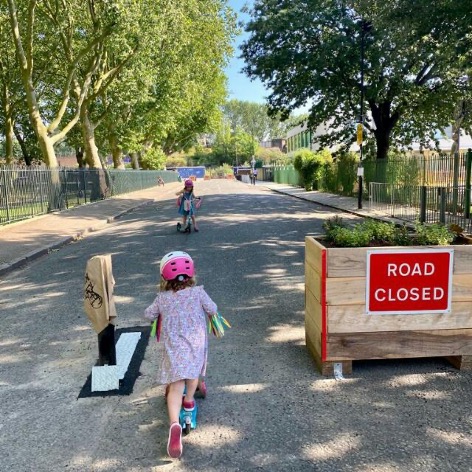Author & Photos: Mike Tisdell. Edited by Iliana Koutsou and Alex Raha
School Streets are temporary closures for motor traffic at the start and end of the school day. An effective school street creates a welcoming and safe environment for children travelling to and from school on foot, scooter or bicycle, free from road danger. At Lewisham Cyclists we think it’s positive to see such a large number of school streets being rolled out at pace across the borough.
We believe effective school streets can:
- Help reduce traffic and the pollution it causes.
- Create a safer environment for everyone travelling to and from school.
- Encourage travel to school by sustainable and active modes; especially walking, scooting and cycling.
For a detailed overview of School Streets in general we recommend this report from Mums for Lungs, Transport for Quality of Life , Possible and the Active Travel Academy: School Streets: Reducing children’s exposure to toxic air pollution and road danger
Below, we have look at Lewisham’s 25 upcoming school streets for which designs have been released for consultation, to see how impactful we think each of these interventions will be. A brief summary of how we have assessed each individual scheme follows below.
We’d love to hear any experiences you’ve had related to Lewisham’s ongoing programme of School Streets, to help inform any recommendations we make to the council for improvements that could be made, and to better understand what’s working well. You may also want to correct us on anything here, especially if the details of the scheme appear to have changed since we wrote this. Email us at lewishamcyclists@gmail.com
If you feel a School Street is making a positive difference, please do let the council know via the commonplace website. You can also find links to each individual scheme by clicking on the plan for each school below.
Good:
These are the schemes that largely meet what we’d expect from a school street.
- In general, they remove motor traffic over a reasonably large area outside the school gates, and often the whole street (or streets) where the school’s entrance(s) are situated.
- These do not rely upon school staff to be present to enforce the closure for the active periods, and are instead enforced either by physical barriers (usually lockable bollards), or automatic number plate recognition cameras.
- Many of these could still be improved further with extension of the area closed to motor traffic. In a number of cases, it is noted these otherwise good schemes have the potential to exacerbate existing parking problems just outside the area of the closure, so we suggest these will need close monitoring with this consideration in mind, following their implementation.
Ashmead: Good to see a full street closure here which will bring a big improvement. In the future we’d like to see more work done in the surrounding streets to reduce rat-running and reduce traffic danger.
Brindishe Green: This treatment creates a decent sized traffic-free area outside the school gates, and since this sits in a Controlled Parking Zone it is hoped Ardmere Road and the Eastern end of Beacon road do not become unofficial car parks. Good to see contra-flow cycling formally adopted.
Cooper’s Lane: A much-needed closure of a heavily trafficked street at drop-off and pick-up time. Though there is potential for parking moving onto Kingsand Rd, it is hoped the scheme could be widened to include this street if needed.
Eliot Bank: This creates a decent sized traffic-free area outside the school gates, which is really positive. We do note there is potential for increased traffic and parking at the Dartmouth Road end of Thorpewood (outside Holy Trinity C of E primary) and/or around Round Hill/Radlet Ave.

Gordonbrock: A full-street closure for Amyruth Road, with a permanent exit-only treatment at Brockley Grove end including a useful contra-flow entry for cycling. However we would like to see the same treatment for Gordonbrock road, as this also has an entrance currently in use for drop off and pick up.
Haseltine: Very welcome to see a good traffic-reduction scheme for a school in one of our most car-dominated areas, with a closure area covering the whole loop around Bell Green Lane and Haseltine. In its current form this loop hosts far too much ‘school run’ traffic and makes travelling actively to this school a negative experience. Pavement parking along Bell Green Lane is already an issue, however, and since this scheme could potentially lead to more motorists arriving from the South, further physical measures to prevent pavement parking at this location could potentially further improve what is already a very good scheme.
Holbeach: We are really pleased to see a permanent filter at this location, since this is something we proposed and campaigned for. This will bring a big improvement, not just for school journeys, but for active travel in the area at all times. We would support further work to reduce traffic in this area generally, which would suit Low Traffic Neighbourhood treatment, as well as further measures to deal with the Nelgarde Road entrance.
John Ball: Promises to have a positive impact, reducing traffic on the street approaching the school and creating a safe car-free area directly outside. A closure here should deter drive-by pick-ups and leaves little opportunity for parking just beyond the closure, except in the paid car-park.
Kilmorie: It is good to see both entrances tackled here, which makes this another positive scheme. This could perhaps be even more ambitious if it covered the whole section of Elsinore road between Woolstone and Vancouver Roads, but another very welcome scheme.
Myatt Garden: It is great to see the full length of both one-way streets that provide access to the school are filtered in this scheme, and that both enforced by ANPR – a good scheme.
Rushey Green & Holy Cross: Another good scheme that deals with both entrances over a sensible full hour period. We hope that the sections of both Penerley and Culverley left open (at the Bromley Road end) do not attract a concentration of parking issues, or lots of potentially dangerous U-turn movements. If this is a case, extending the school streets to include them seems a relatively simple fix.
Prendergast Ladywell Fields: We are pleased to see a scheme that deals with a long-standing issue at this location. Although the Lewisham commonplace website suggests this might be a staffed closure, happily it appears CCTV is being installed to enforce this closure.
Could be Improved:
These are schemes that we felt fell short, for one reason or another, of what we’d like to see in a School Street. Although in many cases, these are likely to bring benefits to the area directly outside the school gates, with more force than zig-zag markings alone, the most common concern here is the very limited areas these closures cover. In these cases, School Streets are unlikely to provide a significant nudge to convince parents and pupils to travel by foot, scooter or bicycle. As such, we didn’t feel they were likely to have significant effects on levels of driving, and so won’t bring the reduction in school-run traffic, or the associated benefits this brings for those who choose to travel to school by sustainable modes.
Adamsrill: Although we appreciate extension here would require more measures installed to deal with the junctions (e.g. w/ Fairwyn and Champion Rds) we believe this School Street could be improved by extension in both directions along Adamsrill Road. One benefit of this would be covering the entrance of the nursery, just a few doors down towards Perry Rise.
All Saints CofE: Although it’s good to see the whole of Blackheath Vale included, this School Street could be even more impactful if the filter were installed on Duke Humphrey Road, at the mini-roundabout where it meets with Tranquil Vale. We hope ANPR cameras (as the plans on Lewisham’s commonplace suggests) will be installed to enforce this filter, rather than using staffed barriers as the accompanying text suggests.
Athenley: We’d like to see this school street include the whole of Athenley Street and a decent stretch of King Alfred avenue. The current scheme extent is very limited.
Deptford Green: This is another scheme we thought could include more of the street. We do note good links for active travel exist via Fordham Park and Woodpecker walk in particular, which having a traffic-free space directly outside the school gates allows children and parents to access safely. However, taking the closure point to the junction w/ Sanford Street might have done more to discourage driving and left more space for walking, scooting and cycling.
Good Shepherd: We would like to see this School Street scheme extended both west along Moorside Rd (e.g. to Durham Hill) and to include the small street opposite the school which connects to Capstone Road.
Tidemill Academy: Collapsible bollards to prevent parents using the car park here is a welcome development, but considering this is not the main entrance to the school (with pupils generally arriving and departing via Giffin Street and Deptford High Street), we would like to see more done to enable active travel to this school. We are actively campaigning for more to be done in Deptford to enable active travel, including pedestrianising Deptford High Street and building protected cycle tracks on Deptford Church Street.
Rathfern: We would like to see this encompass a wider area, although we note in its current extent it should bring about a good improvement in a problem area.
St John the Baptist: We’d like to see this cover a much larger area, perhaps encompassing the whole loop round to Cotton Hill.
St William of York: It is positive to see some action here, on what can be a relatively busy street. We would welcome a chance to review the scheme design for the proposed additional traffic calming measures, which are described as consisting of “two sets of kerb build outs with a give way section of road between the road narrowing”. It is good to see attempts being made to address speeds on this steep hill, but we note treatments of this type can often be hostile for people cycling.
Not a School Street?
These are schemes, which though in some cases may bring an improvement in conditions in the close vicinity of schools, would not match our understanding of what a School Street is.
Conisborough: Although this suggested intervention should reduce some conflict between motor vehicles and access to the school gates, this is not really a timed closure of a School Street, but rather to an adjacent car park. We think the bollard here should be permanent, rather than a timed restriction.
Lucas Vale: This scheme consists only of temporary bollards to block parking spaces w/ existing double-yellow lines, which is not a School Street as we understand it.

Sandhurst: A pavement widening using water-filled barriers is not a ‘School Street’. Recent examples of treatments of this kind; in Deptford High Street and along the A21 Lewisham High Street near Ladywell, have not provided lasting benefits, as they are prone to being moved. We’d like to see a timed closure here between Brownhill and Sandhurst Road.
Torridon: Another pavement widening scheme using water-filled barriers, which is not a School Street. If a temporary closure were deemed impossible at this school we’d like to see something more robust than this to eliminate the immediate danger of parking outside the school gates.
























